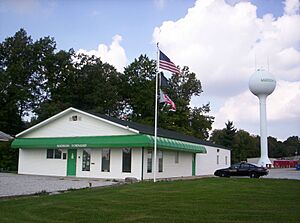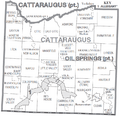Civil township facts for kids
A civil township is a type of local government in the United States. Think of it as a small area within a larger county that has its own leaders and provides services to the people living there. In some places, these areas are simply called "towns" instead of "townships." About twenty states in the U.S. use civil townships to help manage local affairs.
Contents
What is a Civil Township?
A civil township is a small part of a county. It's a bit like a neighborhood or a small town that has its own local government. These townships are usually set up to help manage services for people who live outside of big cities or towns. They make sure that local needs are met, like keeping roads in good shape or providing parks.
How Townships Help Local Communities
Townships play an important role in making sure communities run smoothly. They often handle things that are too local for the county government to manage easily. For example, a township might be responsible for maintaining local roads, managing parks, or even providing fire and police services in some areas. This helps make sure that even smaller communities get the services they need.
Where Are Civil Townships Found?
You'll find civil townships mostly in the Midwest and Northeast parts of the United States. States like Ohio, Indiana, Illinois, Michigan, Pennsylvania, and New York use them. Each state might have slightly different rules for how its townships work, but the main idea is always the same: to provide local government services.
What Do Township Governments Do?
The main job of a township government is to provide services to the people who live within its borders. The specific services can vary a lot from one township to another, but here are some common ones:
Managing Local Roads
One of the most common jobs for townships is taking care of local roads. This includes things like plowing snow in winter, fixing potholes, and making sure road signs are clear. This is especially important in rural areas where county governments might not be able to reach every small road easily.
Parks and Recreation
Many townships manage local parks, playgrounds, and community centers. They might organize sports leagues, summer camps, or other activities for kids and families. This helps create fun and safe places for people to gather and enjoy their free time.
Public Safety Services
In some townships, the local government might provide fire protection or even a small police force. This helps keep communities safe and ensures that help is available quickly in an emergency. Other townships might rely on the county or state for these services.
Other Local Services
Townships can also handle other important services like trash collection, zoning (deciding how land can be used), or even maintaining cemeteries. They often act as the first point of contact for residents with local issues.
How Are Townships Governed?
Civil townships have their own elected officials who make decisions for the community. These officials are usually residents of the township, so they understand the local needs very well.
Township Board or Trustees
Most townships are governed by a small group of elected officials, often called a "township board" or "board of trustees." These people meet regularly to discuss issues, make decisions, and manage the township's budget. They are like a mini-city council for the township.
Other Elected Officials
Depending on the state, a township might also have other elected officials. These could include a township clerk (who keeps records), a township treasurer (who manages money), or even a supervisor (who acts as the main leader). These roles help ensure that the township runs smoothly and that public money is used wisely.
Why Do Townships Exist?
The idea of townships goes way back in American history. When the United States was first growing, people needed a way to organize land and provide basic services as new areas were settled.
Historical Roots
Many townships were created based on a system called the Public Land Survey System. This system divided land into square sections, which often became the boundaries for townships. This made it easier to sell land and set up local governments in new territories.
Local Control
Townships allow for a very local form of government. This means that decisions about local issues are made by people who live right there in the community. It gives residents a direct say in how their immediate area is managed, which can be very empowering.
Images for kids
-
Map of Cattaraugus County, New York showing municipal and township organization
-
1877 map of Warren County, Indiana. Among its civil townships, only Pine Township exactly matches a survey township with 36 sections.




